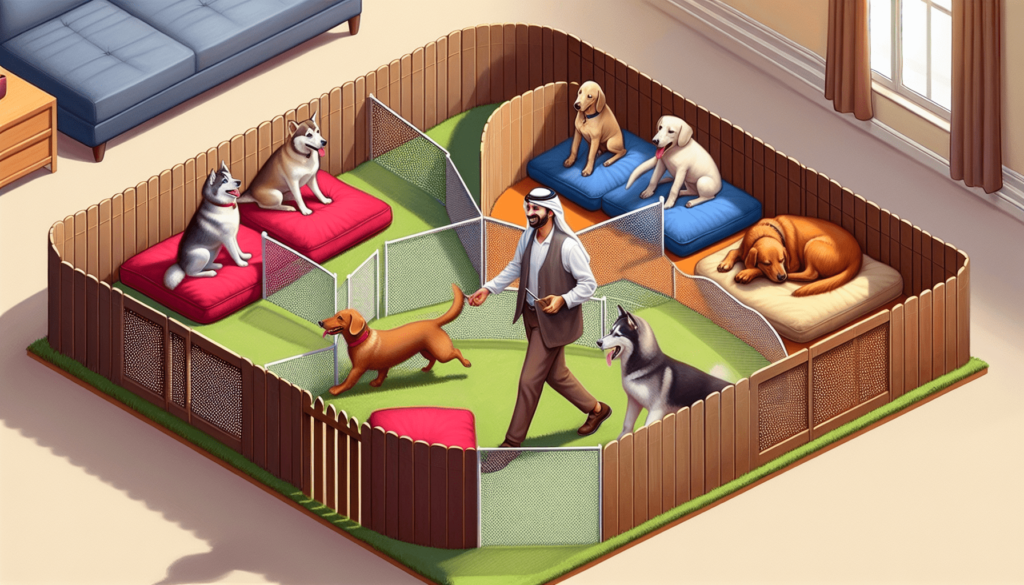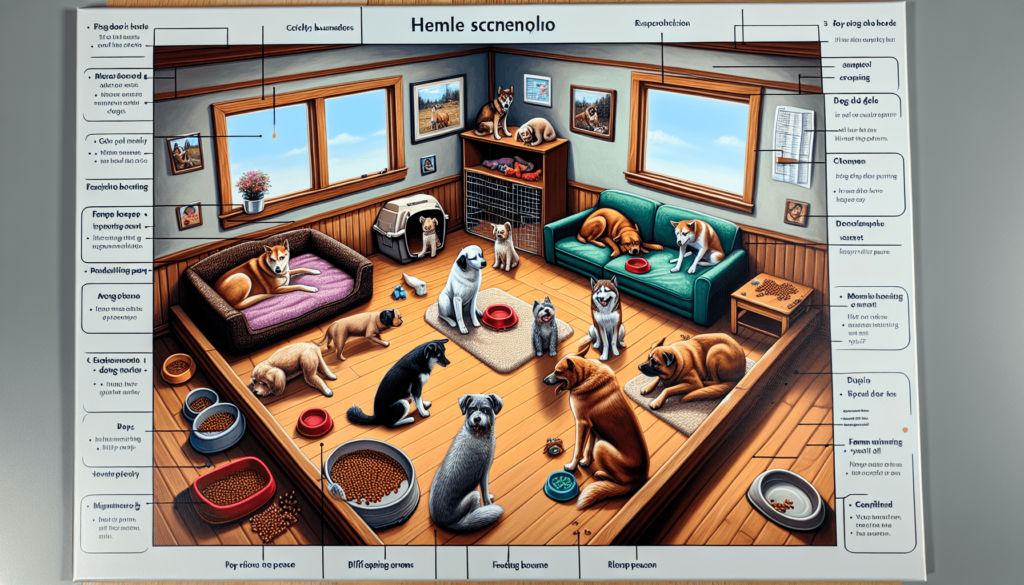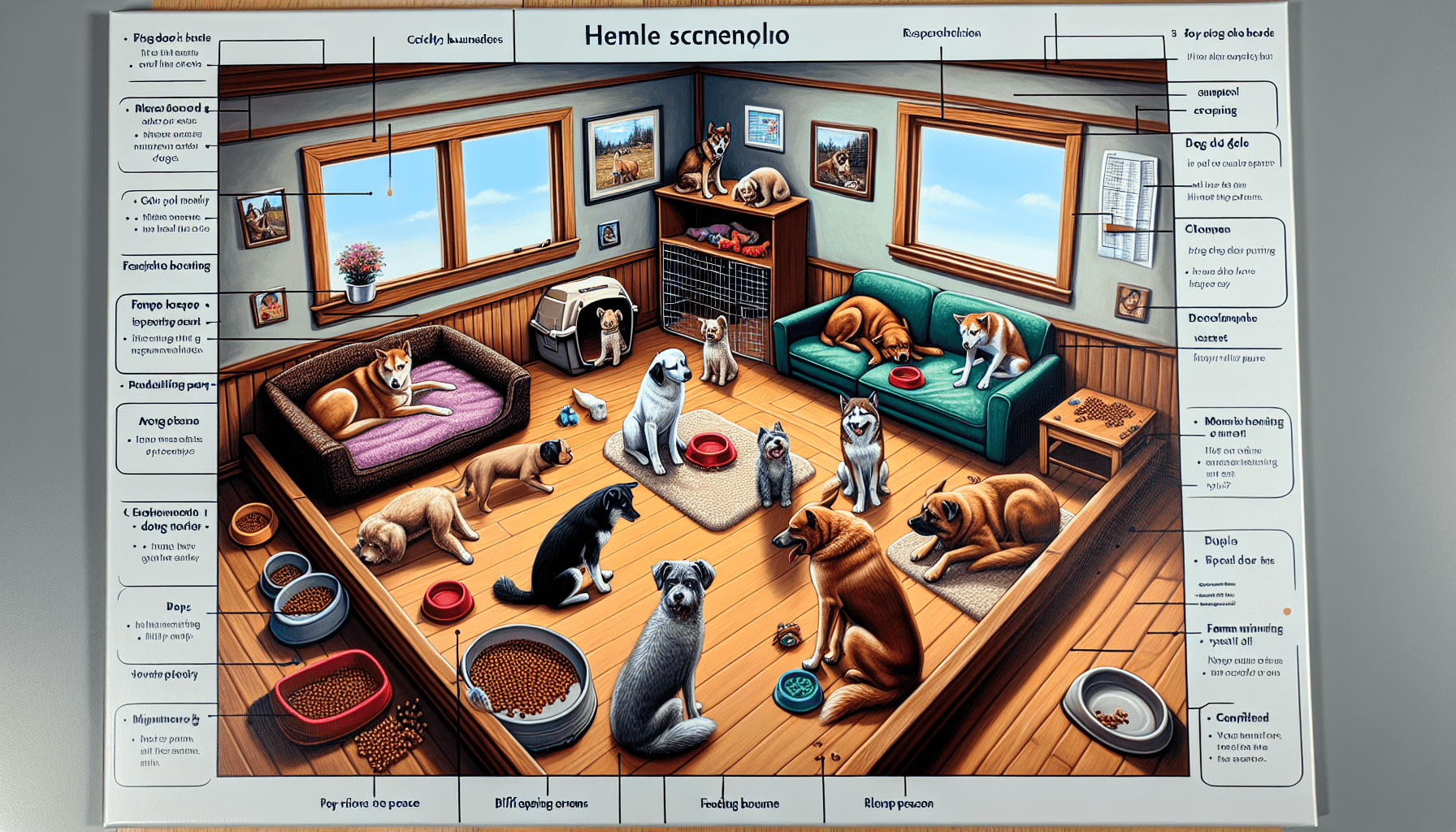Living in a multi-dog household can be a wonderfully rewarding experience, filled with love, laughter, and companionship. However, it can also come with its fair share of challenges. From managing their different personalities to ensuring they all get along, maintaining harmony amongst multiple dogs requires some thoughtful strategies. In this article, you will find valuable tips and tricks to help you successfully navigate the ups and downs of a multi-dog household, ensuring a harmonious and happy environment for everyone involved.

Establish a Routine
Having a routine is essential when managing a multi-dog household. It provides structure and stability, which can help reduce stress and prevent conflicts among your canine companions.
Set consistent feeding times
Establishing consistent feeding times can be beneficial for multiple reasons. First, it helps ensure that each dog receives their required nutrients at the appropriate intervals. Second, it prevents food-related conflicts or resource guarding between dogs. By feeding your dogs at the same times every day, you create a predictable and harmonious feeding routine.
Create a schedule for exercise
Regular exercise is vital for the physical and mental well-being of your furry friends. When managing multiple dogs, it’s important to create a schedule for exercise that allows you to provide each dog with individual attention and playtime. Whether it’s going for walks, playing fetch, or engaging in interactive games, make sure to allocate separate time for each dog to prevent competition or conflicts over toys or attention.
Establish designated sleeping areas
Dogs need their own space to rest and unwind. Creating designated sleeping areas for each dog can help prevent territorial disputes and enhance their overall comfort. Provide separate beds or resting spots in different areas of your home. This way, each dog can have their own cozy corner to relax in, reducing the likelihood of tension or squabbles over sleeping arrangements.
Introduce Dogs Slowly
Introducing new dogs into your multi-dog household requires careful management and proper introductions. It’s crucial to take it slowly and allow for gradual adjustments to ensure a peaceful and harmonious coexistence.
Allow them to meet in a neutral territory
When introducing new dogs to your existing pack, it’s best to do so in a neutral territory. This could be a park or any area unfamiliar to all the dogs. By choosing a neutral location, you reduce the chances of territorial behaviors and establish a more balanced initial meeting environment.
Supervise initial interactions
During the initial interactions between your dogs, it’s essential to closely supervise and monitor their behavior. Keep a close eye on their body language, ensuring that their interactions remain positive and free from any signs of aggression or tension. If necessary, use leashes or barriers to maintain control and prevent any unwanted incidents.
Gradually increase their time together
As your dogs become more comfortable with each other, gradually increase the amount of time they spend together. Begin with short, supervised playdates, gradually extending the duration as they display friendly and relaxed behavior. This gradual approach allows the dogs to develop trust and familiarity, minimizing the chances of conflicts or tension.
Provide Sufficient Resources
Resource guarding, where dogs become possessive over items such as food, toys, or resting spots, can escalate into conflicts in a multi-dog household. Providing sufficient resources for each dog can prevent such issues from arising.
Ensure each dog has their own food and water bowls
To prevent conflicts during mealtime, it’s crucial to provide each dog with their own food and water bowls. They should be placed in separate locations and clearly labeled for individual use. This ensures that each dog can eat and drink without feeling the need to guard or compete for resources.
Provide multiple beds or resting spots
Just like with food bowls, it’s important to offer multiple beds or resting spots in different areas of your home. Dogs should have the option to retreat to their own designated resting area whenever they desire. By providing separate spaces, you eliminate any potential guarding behavior and promote a peaceful coexistence.
Offer an ample supply of toys and chews
Dogs love to play, and having an abundant supply of toys and chews for each dog can prevent resource guarding issues. Ensure that each dog has access to a variety of playthings, and periodically rotate and introduce new toys to keep their interest fresh. Having enough toys and chews for all dogs eliminates the need for competition and reduces the likelihood of disputes over prized possessions.
Promote Individual Attention
Even within a multi-dog household, it’s essential to provide each dog with individual attention and quality time. This helps build their bond with you, strengthens their training, and ensures they feel valued and loved.
Spend one-on-one time with each dog
Schedule regular one-on-one time with each dog to cater to their specific needs. It could be a short training session, a walk, or simply cuddling on the couch. By dedicating individual time, you show each dog that they are important and reinforce your connection with them.
Offer separate training sessions
Training is a vital aspect of fostering a well-behaved and happy dog. Conducting separate training sessions for each dog allows you to focus on their unique learning requirements and prevents any competition for attention or confusion. Personalized training also helps to strengthen the bond between you and each individual dog.
Provide individual playtime and affection
While group play and interactions are important, it’s equally essential to offer individual playtime and affection for each dog. Engage in activities that they enjoy, such as playing fetch, participating in interactive games, or simply cuddling and giving belly rubs. This individual attention reinforces their sense of belonging and helps prevent any feelings of jealousy or resentment.

Establish Clear Ground Rules
Setting clear ground rules for behavior and establishing consistent boundaries is crucial in maintaining a harmonious multi-dog household.
Teach basic obedience commands to all dogs
Ensuring that all your dogs have a solid foundation of obedience training is essential. Teaching them basic commands, such as sit, stay, and leave it, helps establish structure and reinforces their understanding of acceptable behavior. Consistent training for all dogs also fosters an environment of fairness and equality.
Enforce rules consistently
Consistency is key when enforcing rules within a multi-dog household. Dogs thrive on predictability, so it’s important to establish and enforce the same rules for all dogs. Whether it’s not allowing them on the furniture or restricting access to specific areas of the house, consistency ensures fairness and avoids confusion or disputes.
Set boundaries for access to certain areas
Establishing boundaries regarding access to certain areas of your home can help prevent conflicts and resource guarding. Use physical barriers or gates to restrict access to rooms or spaces where conflicts are likely to occur, such as around food or resting areas. Clear boundaries promote respect and minimize the potential for territorial behavior.
Address Aggression or Dominance Issues
In a multi-dog household, it’s important to address any aggression or dominance issues promptly and effectively to maintain a peaceful living environment.
Consult with a professional dog trainer or behaviorist
If you notice any signs of aggression or dominance between your dogs, it’s important to seek professional help. A qualified dog trainer or behaviorist can assess the situation and provide valuable guidance on how to address the underlying issues. They can help you develop a training plan that focuses on positive reinforcement techniques to modify behavior and promote healthy interactions.
Implement positive reinforcement training methods
Positive reinforcement training methods, such as rewarding good behavior and ignoring unwanted behavior, are highly effective when dealing with aggression or dominance issues. Reinforcing and rewarding desirable behaviors helps redirect the dogs’ focus and encourages positive interactions. Be patient and consistent in your training, and remember to never use punishment or harsh methods, as these can exacerbate aggression.
Supervise and manage interactions between dogs
Until any aggression or dominance issues are resolved, it’s crucial to closely supervise and manage interactions between your dogs. This may involve using leashes or muzzles during certain interactions and slowly reintroducing the dogs under controlled circumstances. Providing clear guidance and redirecting unwanted behavior in real-time helps prevent any escalation and allows for a safe and controlled environment.
Prevent Resource Guarding
Resource guarding can create tension and conflicts among dogs in a multi-dog household. Implementing strategies to prevent resource guarding behaviors can help maintain a peaceful coexistence.
Feed dogs in separate areas
To prevent food-related resource guarding, it’s advisable to feed each dog in a separate area. This ensures that they can eat without feeling the need to defend their food from other dogs. Maintaining physical distance during mealtime promotes a calm and stress-free feeding experience for all dogs involved.
Monitor toy sharing and remove valuable items
When it comes to toys, certain dogs may exhibit resource guarding tendencies. Keep an eye on their interactions with toys and remove any highly valued items that could trigger conflicts. Instead, provide a variety of toys for all dogs to enjoy, reducing the likelihood of disputes over particular toys.
Use positive reinforcement for sharing behaviors
Encouraging sharing behaviors through positive reinforcement is key to preventing resource guarding. Rewarding and praising dogs for voluntarily sharing toys, chews, or resting spots reinforces the idea that cooperation and sharing are positive experiences. This helps create a harmonious and cooperative atmosphere among the dogs.
Provide Physical and Mental Stimulation
Keeping your dogs physically and mentally stimulated is essential for their overall well-being and can help prevent behavioral issues within a multi-dog household.
Engage dogs in regular exercise
Regular exercise is crucial for maintaining your dogs’ physical health and managing their energy levels. Each dog should receive individual exercise tailored to their breed, age, and activity level. Whether it’s going on walks, runs, or engaging in agility training, providing regular exercise helps release excess energy, reduces stress, and promotes a more harmonious living environment.
Offer puzzle toys and interactive games
Mental stimulation is just as important as physical exercise for dogs. Providing puzzle toys and interactive games challenges their minds and keeps them engaged. Experiment with different types of toys and puzzles that require problem-solving and reward-based interaction. Rotating and introducing new toys regularly helps keep dogs mentally stimulated and prevents boredom.
Rotate and introduce new toys regularly
Dogs can quickly lose interest in their toys if they are always readily available. To keep their toys exciting and engaging, rotate them regularly. Store some toys away and bring out different ones every few weeks. Introduce new toys to keep their curiosity piqued and to prevent possessiveness or disputes over particular toys.
Maintain Individual Health Care
Ensuring the individual health care needs of each dog are met is crucial in a multi-dog household. Taking care of their veterinary needs separately helps prevent the spread of illnesses and supports the overall well-being of each dog.
Schedule separate vet appointments
To maintain the individual health of each dog, schedule separate vet appointments. This allows for dedicated time with the veterinarian to address any specific concerns and ensures that each dog receives the necessary vaccinations, check-ups, and treatments without potential cross-contamination.
Administer medications and treatments separately
If any of your dogs require medications or treatments, it’s important to administer them separately to avoid any mix-ups or potential conflicts during the process. Keep medications securely stored and follow the prescribed dosages strictly for each individual dog. Maintain a routine to ensure consistency in administering treatments.
Ensure each dog receives necessary vaccinations
Vaccinations are essential for preventing the spread of diseases and ensuring the overall health of your dogs. Make sure that each dog receives the necessary vaccinations according to their age, breed, and local regulations. Keeping their vaccinations up to date protects them individually and maintains a safe environment for all dogs in the household.
Monitor and Manage Stress Levels
In a multi-dog household, it’s crucial to pay attention to the stress levels of your furry friends. By monitoring and managing stress, you can create a more harmonious and relaxed living environment.
Watch for signs of stress or tension
Familiarize yourself with the signs of stress or tension in dogs, such as excessive panting, pacing, growling, or withdrawal. Regularly observe your dogs and monitor any changes in their behavior or body language. By being aware of these signs, you can intervene early and address any potential stressors.
Provide quiet and calm spaces for each dog
Designate quiet and calm spaces within your home where each dog can retreat to for relaxation and solitude. These spaces should be free from distractions and provide a sense of security. Providing individual spaces helps dogs manage stress and allows them to recharge in a peaceful environment.
Use calming aids or supplements if needed
If you notice that any of your dogs are particularly prone to stress or anxiety, consider using calming aids or natural supplements. These can include products such as pheromone diffusers, calming sprays, or herbal remedies that help promote relaxation. Always consult with your veterinarian before introducing any new supplements or medications.
Balancing a multi-dog household requires careful attention to each dog’s needs, consistent training, and proactive management. By establishing a routine, introducing dogs gradually, providing sufficient resources, promoting individual attention, setting clear ground rules, addressing aggression issues, preventing resource guarding, providing physical and mental stimulation, maintaining individual healthcare, and monitoring stress levels, you can create a harmonious and happy home for all your furry companions. Remember, patience, consistency, and love are the pillars of a successful multi-dog household.

